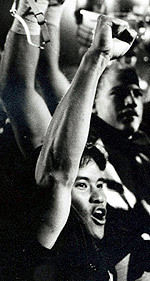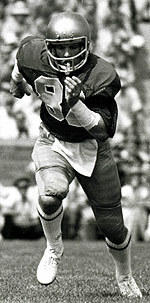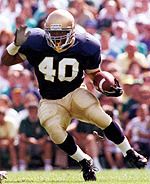Sept. 10, 2004
By Craig Chval
By the end of his sophomore year at Notre Dame, Reggie Brooks was ready to come home. The Tulsa, Okla., native had followed in the footsteps of his brother, Tony, by spurning overtures from local universities to play at Notre Dame.
But while Tony had earned significant playing time as a freshman in 1987 and was a star on Notre Dame’s 1988 national championship team, Reggie had yet to enjoy similar success. Brooks had already informed the Notre Dame and Oklahoma State University coaches of his intention to transfer and play for the Cowboys.
There was just one more person Brooks had to talk to, his father, Raymond.
“He said that I was going to finish what I started, and that I was going to stay at Notre Dame,” recalls Brooks.
After one more season of biding his time, Reggie made Notre Dame fans very grateful that Raymond Brooks halted those transfer plans. As a senior in 1992, Reggie had one of the most amazing seasons in Notre Dame history. He rushed for 1,343 yards on 8.04 yards per carry, second only to George Gipp’s 1920 mark of 8.10 in the Notre Dame record book.
Brooks announced his presence to the college football world in spectacular fashion against Michigan in Notre Dame Stadium. His spinning, whirling 20-yard touchdown run through five Wolverine would-be tacklers was ESPN’s play of the year. The phenomenal effort left Brooks nearly unconscious and without any recollection of the play.
When Brooks saw the run on film, he was as incredulous as everybody else.
“I did that?” Brooks remembers thinking.
It truly was an unbelievable season, as Brooks his season by finishing fifth in the 1992 Heisman Trophy balloting, the last top-10 finish by a Notre Dame player.
In an ironic twist, the young man who was ready to put South Bend in his rear view mirror for good has returned to Notre Dame. Back in Tulsa after playing several seasons in the National Football League, Reggie and his wife, Christina, were talking about where they wanted to raise their four children – daughters Aespyne and Rayna, and sons Alex and Gabe.
Just a few weeks later, Brooks received a call about a vacancy in the University’s Office of Information Technologies.
“I enjoy working with computers and I enjoy working with people,” says Brooks.
“And it’s great to be back.”
CATCHING UP WITH … REGGIE HO
He was the most unlikely of heroes.
Few Notre Dame fans had even heard of Reggie Ho prior to September 10, 1988. But with three field goals that night, the five-foot, five-inch, 135-pound walk-on kicker had done more than his share to help the young Irish in their bid to knock off ninth-ranked Michigan.
But even more would be required of Ho, playing in his first-ever Notre Dame game. Michigan’s Mike Gillette booted a 49-yard field goal with 5:39 remaining in the fourth quarter, giving the Wolverines a 17-16 lead over the 13th-ranked Irish.

Reggie Ho provided the game-winning field goal vs. Michigan in 1988.
|
Notre Dame drove to the Michigan nine-yard line, where on fourth down and with 1:13 to play in the game, Ho converted his fourth field goal of the night, a 26-yarder.
The season-opening upset started Notre Dame on its way to a 12-0 season and the national championship, capped by a 34-21 win over West Virginia in the Fiesta Bowl.
“Standing on the sideline of the Fiesta Bowl with the clock winding down, it kind of dawned on me that we were going to win a national championship,” recalls Ho.
“It was great to bring back some glory to Notre Dame.”
Today, Ho lives in the Philadelphia area with his wife, Maromi, and one-year-old son, Ethan. A cardiologist at the Thomas Jefferson University Hospital, Ho’s subspecialty is electrophysiology.
Patients often recognize Ho for his football exploits at Notre Dame. It’s a good bet those patients are reassured by knowing that Ho has been coming through under pressure for many years.
CATCHING UP WITH … Kris Haines
By his own admission, Kris Haines couldn’t catch a cold during his freshman season as an Irish wide receiver. By the time he left Notre Dame, Haines had become famous for his exploits in the cold.
Haines was quarterback Joe Montana’s favorite receiver in 1979, snagging 32 passes, including five touchdowns. Haines’ greatest moment came during the 1979 Cotton Bowl in Dallas – “The Ice Bowl.”
After trailing 34-12 with 7:26 to play, Notre Dame got the ball down 34-28 with 28 seconds to play and no timeouts remaining. With six seconds left, the Irish were on the Houston eight-yard line. After throwing incomplete for Haines, Montana came back with the same call. Haines made a diving catch, barely staying in bounds in the end zone.

Kris Haines caught the game-winning pass from Joe Montana in Notre Dame’s legendary comeback in the 1979 Cotton Bowl – dubbed “The Ice Bowl.”
|
The hands that had too often betrayed him during his freshman year were nearly frostbitten, but they were reliable. Irish head coach Dan Devine was so confident in Haines’ hands that he ordered him to play without gloves in the brutal conditions.
“Dan Devine, bless his soul, came up to me before the game and said, `James Lofton never wore gloves in Green Bay and he’s in the Hall of Fame. You’re not wearing gloves,'” recalls Haines with a laugh.
Haines is still enjoying the benefits of the remedy he employed at Notre Dame to improve his concentration and receiving — martial arts. He now holds four different black belts and teaches martial arts to adults and children.
Haines, who makes his home in the Chicago area with his wife Mary Ann, also teaches physical education while pursing his master’s degree at DePaul University. A veteran of several NFL seasons, Haines also works in football camps sponsored by the Chicago Bears and has been a frequent participant in the Blue and Gold flag football games and the Notre Dame football fantasy camps.







